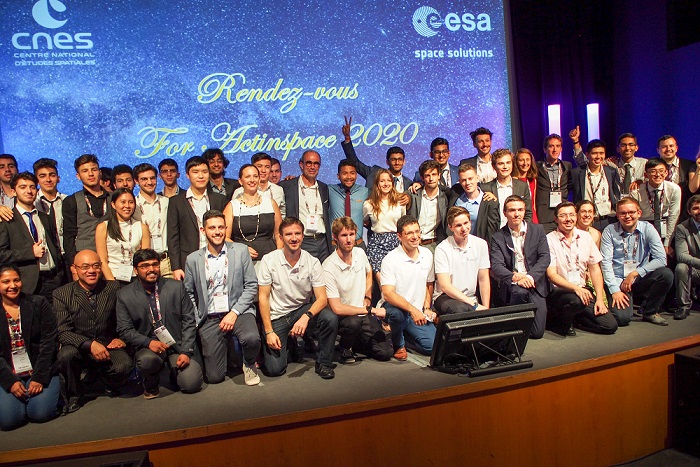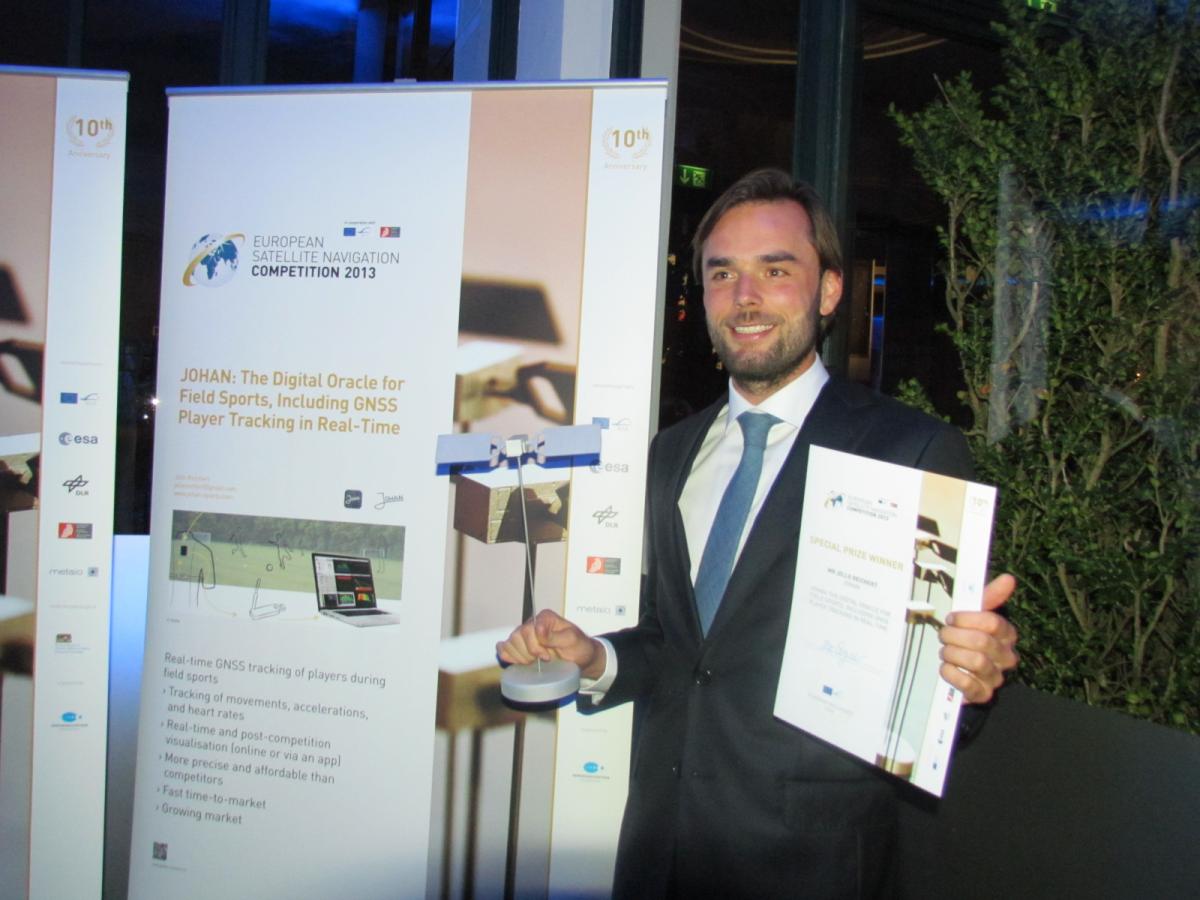The 10th edition of the joint European Satellite Navigation Competition (ESNC) and Copernicus Masters 2013 ceremony was a festive evening held in conjunction with the opening day of the European Space Solutions conference in Munich. The event put the spotlight on innovative entrepreneurs and application developers utilising satellite navigation and earth observation technologies and was attended by high level personalities from government, institutions and industry.
 The ESNC award recognises innovative services, products and businesses that incorporate European satellite navigation technology into everyday life. The European Earth Monitoring competition, the Copernicus Masters, on the other hand, awards ideas and innovative solutions. The two held their most recent joint awards ceremony on 5 November 2013 in Munich.
The ESNC award recognises innovative services, products and businesses that incorporate European satellite navigation technology into everyday life. The European Earth Monitoring competition, the Copernicus Masters, on the other hand, awards ideas and innovative solutions. The two held their most recent joint awards ceremony on 5 November 2013 in Munich.
The awards aim to highlight how space solutions bring tangible, significant and down-to-Earth benefits to the public. And this year’s winners did not disappoint, demonstrating the vast range of applications and sectors that are enabled or enhanced by satellite technology.
The ceremony was followed by an official State reception hosted by the Bavarian Ministry of Economic Affairs and Media, Energy and Technology, held in the Alte Kongresshalle Munchen.
The winners are…
Overall winner: KINEXON
The overall ESNC and Galileo Masters 2013 award went to KINEXON, a Munich-based start-up specialising in smart wearable devices. Their innovation, which also won the Bavarian regional prize, includes a revolutionary wearable sensor that allows for the tracking of an individual or object with centimetre accuracy. A corresponding application uses a secure cloud-computing platform to analyse the data. The concept can be used in sports training, healthcare and logistics – to name just a few of its applications.
Dr Gerd Gruppe from the German Aerospace Centre (DLR) awarded the € 20 000 grand prize to Kinexon founders Dr Oliver Trinchera and Dr Alexander Hüttenbrink.
“As innovation forms the basis of economic success and holds considerable potential for society, the DLR places great emphasis on technology transfer,” said Dr Gruppe. "The ESNC has developed into a driving force behind the innovative use of satellite navigation technologies and a starting point for numerous successful start-ups in Germany, Europe, and the rest of the world."
Special EGNOS prize: JOHAN
 For the sixth straight year, the GSA offered a special prize for the most innovative application using the European Geostationary Overlay Service (EGNOS). EGNOS, which has been an open and free service in Europe since October 2009, augments current satellite navigation systems, radically improving accuracy and precision of positioning and enabling current GPS to be used for such safety-critical applications as aviation.
For the sixth straight year, the GSA offered a special prize for the most innovative application using the European Geostationary Overlay Service (EGNOS). EGNOS, which has been an open and free service in Europe since October 2009, augments current satellite navigation systems, radically improving accuracy and precision of positioning and enabling current GPS to be used for such safety-critical applications as aviation.
Carlos des Dorides, Executive Director of the GSA, presented the € 40 000 prize to Jelle Reichert for his JOHAN application. Billed as ‘the digital oracle for field sports’, JOHAN is a compact, flexible and economic sports training concept that helps monitor individual players’ performances and enables the development of new tactics in such sports as football, rugby and hockey.
“The European GNSS Agency has been cooperating with the ESNC for the past six years and we are convinced this cooperation has provided an excellent platform for promoting EGNOS and Galileo,” said des Dorides. “In addition to helping establish a European Galileo user community, the ESNC also acts as a gateway to a wide range of unique business applications for GNSS programmes.”
The runner ups
Wearable technology was also the subject of the runner up in the overall Galileo Masters competition and winner of the ESA Innovation special prize. Sensovo Navipal took the prizes for his on-going work on the world’s first tactile navigational system capable of connecting a mobile phone GPS to, for example, a vibrating belt.
Third prize was awarded to AlarmApp, a location-based emergency notification system developed to alert volunteer fire fighters in Germany. The application was also named the regional winner in Hesse, Germany. Sharing third prize was ampido, an innovative parking application that enables users to both find available parking spaces and rent out their own. The idea also won the GNSS Living Lab prize, sponsored by AZO.
The DLR Special Prize went to IntegriCom for its idea aimed at protecting Galileo and other GNSS from interference due to deliberate jamming or from atmospheric or ionospheric effects. The innovation is particularly geared for use in aviation applications.
The new EPO special prize went to the French Space Agency CNES for a number of patents it filed to enhance GNSS signals and further improve Galileo’s performance.
The Metaio special prize winner for the most innovative augmented reality application was won by Astrosat for their winter road safety and emergency location system. The system integrates augmented reality and GNSS, allowing one to drive even when a road is completely buried with snow!
Finally, the University Challenge special prize went to the Portuguese regional winner GeoAgenda. The personal reminder app reminds you what needs to be done depending on the time and your current location.
For an overview of the winners in all 32 categories, please visit the ESNC / Galileo Masters website.
Copernicus Master
Satellite navigation and earth observation technologies are becoming increasingly integrated, and this year’s winner of the Copernicus Masters followed this trend. The award went to Hartmut Runge of the Earth Observation Center (EOC) of the German Aerospace Centre (DLR), for his innovative use of landmark-based navigation for the precise positioning that highly-automatic vehicles demand. The DLR navigation method incorporates street lights, crash barrier posts, bridge railings and other roadside features – all easily visible to both vehicles and Earth Observation satellites – into digital maps. The design also won the competition's BMW ConnectedDrive Challenge.
This year the Copernicus Masters welcomed 144 award submissions from 23 countries – a 30% increase on 2012.
A resounding success
In addition to regional prizes, topic-specific special prizes were sponsored by the European GNSS Agency (GSA), the European Space Agency (ESA), the German Aerospace Centre (DLR), Anwendungszentrum GmbH Oberpfaffenhofen (AZO), and - for the first time - the European Patent Office (EPO) and Metaio GmbH. Students and research assistants were also encouraged to submit their ideas to the ESNC University Challenge.
The total prize pool for ESNC 2013 was over one million Euros and attracted over 1000 participants. There were 413 competition entries submitted via 25 partner regions spread across the world. In all, 32 prize categories were awarded.
ESNC 2014
ESNC is an annual international competition that recognises the best ideas in the field of satellite navigation. In 2014 ESNC will kick-off at the European Navigation Conference (ENC-GNSS 2014) with a dedicated session on the competition. The kick-off is scheduled for 15 April at Rotterdam’s World Trade Centre.
The winners will be recognised at the 11th ESNC Awards Ceremony, to be held in late 2014.
Media note: This feature can be republished without charge provided the European GNSS Agency (GSA) is acknowledged as the source at the top or the bottom of the story. You must request permission before you use any of the photographs on the site. If you do republish, we would be grateful if you could link back to the GSA website.